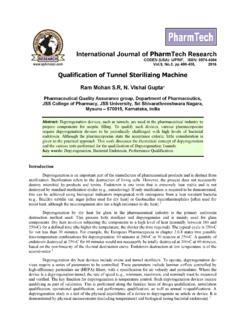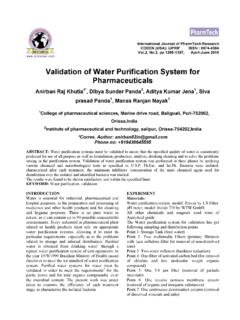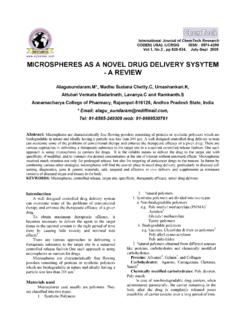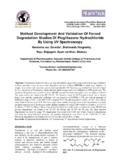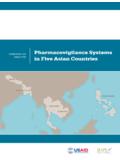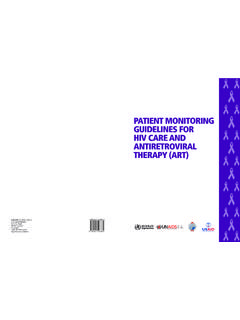Transcription of Quality Risk Management in Pharmaceutical …
1 International Journal of PharmTech Research CODEN (USA): IJPRIF ISSN : 0974-4304 , , pp 908-914, July-Aug 2014 Quality Risk Management in Pharmaceutical industry : A Review V Vijayakumar Reddy*, N Vishal Gupta, H V Raghunandan, U Nitin Kashyap Pharmaceutical Quality Assurance, Department of Pharmaceutics JSS College of Pharmacy, JSS University, Sri ShivarathreeshwaraNagara, Mysore, Karnataka, India-570015.
2 *Corres. Author: Abstract: This article aims to provide principles and examples of tools for Quality Risk Management (QRM) that can be applied to different aspects of Pharmaceutical Quality . These aspects include development, manufacturing, distribution, inspection and submission of review processes throughout the lifecycle of drug substances, drug products and biological Risk Management is an overall and continuing process of minimizing risks to product Quality throughout its life-cycle in order to optimize its benefit and balance the risk.
3 It is a systematic process for the evaluation, control, communication and review of risks to the Quality of the medicinal product. The basic QRM process should include the level of effort, formality and documentation of QRM process which should commensurate with level of risk. QRM principles are utilized effectively in many areas of business and government including business, insurance, work-related safety, public health, pharmacovigilance and by agencies regulating these industries. The risk assessment process should be carried out by analyzing, identifying and evaluating the risk and the QRM plans should be reviewed after their follow up.
4 The QRM implementation provides documented, clear and reproducible methods to accomplish steps of QRM process based on current knowledge about assessing the probability, severity and sometimes detectability of the risk. Using QRM tools, the Pharmaceutical industry and regulators can evaluate, control, communicate and review the risks . Effective QRM implementation can facilitate better and well-versed decisions which can provide regulators with greater assurance of a company s ability to deal with possible risks .
5 Keywords: Quality Risk Management ,Risk- based approach, Patient safety, Product Quality . Introduction Since a couple of years Quality Risk Management (QRM) has become a mandatory regulatory requirement towards healthcare organizations. QRM is an overall and continuing process of minimizing risks to product Quality throughout its life-cycle in order to optimize its benefit and balance the risk. It is a systematic process for the evaluation, control, communication and review of risks to the Quality of the medicinal product.
6 It supports science based and practical decisions when integrated into Quality systems, examples of Quality systems include Validation, Quality Defects - Investigation, Auditing, Inspection, Documentation, Training etc. Quality Risk Management principles are effectively utilized in many areas including business, insurance, work related safety, public health, pharmacovigilance, and by agencies regulating these industries. Even though there are some examples of the use of Quality risk Management in the Pharmaceutical industry , today they are limited and do not represent the full contributions that risk Management has to offer.
7 In relation to pharmaceuticals, though there are a variety of stakeholders, including medical practitioners and patients as well as government and industry , the safety of the patient by managing the risk to Quality should be considered prime importance. The manufacturing and use of a drug product, including its components, necessarily involve some degree of risk. An effective QRM approach can further ensure the high Quality of the drug product to the patient by V Vijayakumar Reddy et al PharmTech ,6(3),pp 908-914.
8 909 identify and control potential Quality issues during development and manufacturing. Use of QRM can improve the decision making if a Quality problem arises. Effective QRM implementation can facilitate better and well-versed decisions which can provide regulators with greater assurance of a company s ability to deal with possible risks .[ 1,3] Principles of Quality Risk Management [1,2] Four primary principles of QRM are: The assessment of the risk to Quality should be based on scientific knowledge and ultimately link to the protection of the patient.
9 QRM should be dynamic, iterative and responsive to change. The level of effort, formality and documentation of the QRM process should be commensurate with the level of risk The capability for continual development and enhancement should be embedded in the QRM process. General Quality Risk Management Process Quality Risk Management is a systematic process for evaluation, control, communication and review of risks to the Quality of the drug product across the product lifecycle. Risk can be defined as the combination of the probability of occurrence of harm and the severity of that harm.
10 [4,5] Figure 1: Overview of a typical Quality Risk Management process[1] Initiating a Quality Risk Management Process Quality Risk Management should include systematic processes designed to organize, facilitate and improve science-based decision making with respect to risk. Steps used to initiate and plan a Quality risk Management process might include the following:[1] Define the problem and/or risk question, including relevant assumptions identify the potential for risk. Assemble background information and/or data on the potential hazard, harm or human health impact applicable to the risk assessment.
